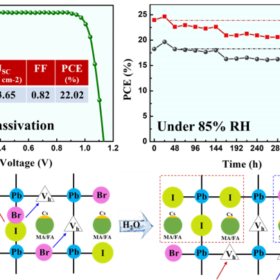
Scientists in China have used a fluorine-containing Lewis acid treatment to develop a perovskite cell that is said to retain between 63% and 80% of its initial efficiency after 14 days under 75% and 85% relative humidity.
Researchers at China’s Xi’an Jiaotong University have developed a solar cell based on multiple-cation lead mixed-halide perovskite (MLMP), which they claim has a stronger moisture resistance compared to cells based on single-halide perovskites.
They claim that mixed halides offer the chance to manufacture more reproducible, thermally stable films with higher crystal qualities. However, these halides also suffer from stability issues due to abundant point defects and dangling bonds at the grain boundary and film surface.
In order to address this problem, the scientists have resorted to interface engineering. They used phosphorus-containing Lewis acid and base molecules such as triphenylphosphine oxide (TPPO), tetraisopropyl methylenediphosphonate (TMPP), and tris (pentafluorophenyl) phosphine (TPFP) in the surface passivation process.
According to their findings, encapsulated cells based on TMPP and TPFP showed the largest enhancements in efficiency and moisture stability, which were achieved through suppressed halide segregation based on an efficient Lewis acid passivation.
The TPFP treatment offers the best passivation effect due to the interaction of molecules and surface defects. “Its strong surface passivation to halide defects can not only reduce recombination but also suppress phase segregation,” the researchers explained.
The cell is described in the study Multifunctional Phosphorus‐Containing Lewis Acid and Base Passivation Enabling Efficient and Moisture‐Stable Perovskite Solar Cells, published in Advanced Science News.
Lắp đặt điện mặt trời Khải Minh Tech
https://ift.tt/2X7bF6x
0906633505
info.khaiminhtech@gmail.com
80/39 Trần Quang Diệu, Phường 14, Quận 3
Lắp đặt điện mặt trời Khải Minh Tech
https://ift.tt/2ZH4TRU
Không có nhận xét nào:
Đăng nhận xét